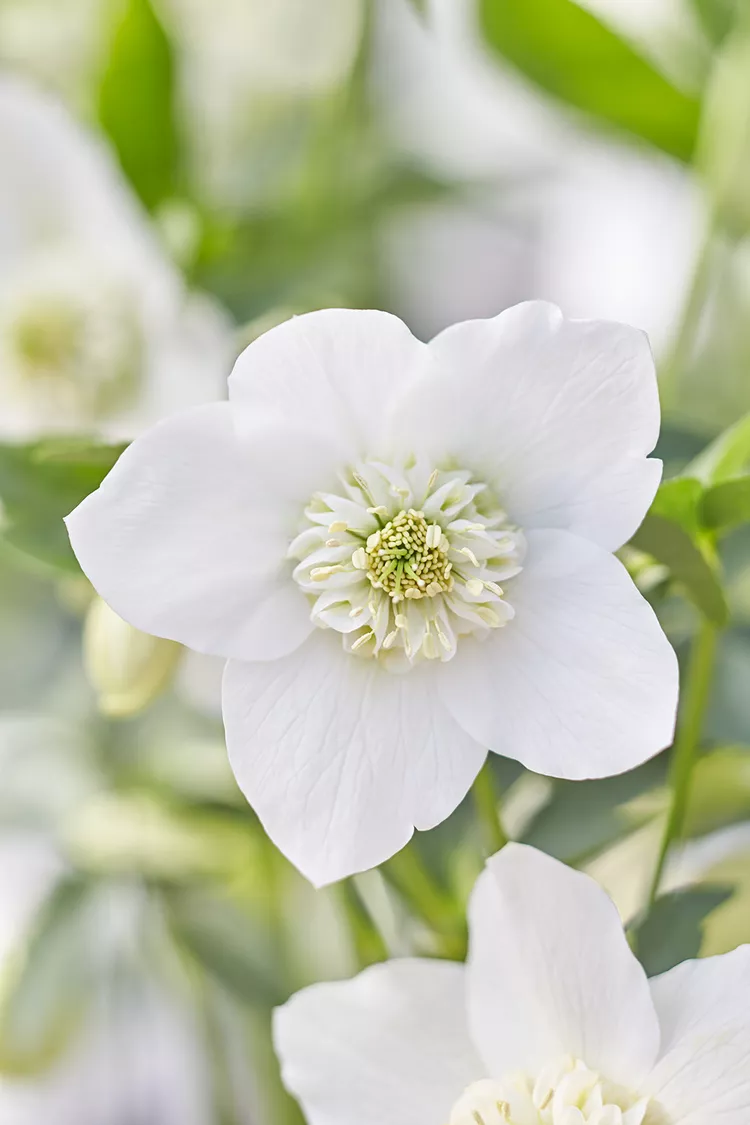7 Best Perennial Flowers That Bloom in Winter

Winter’s short days and low temperatures may reduce the time we spend in the garden, but when we do bundle up and step outside, the sight of some colorful flowers really brightens our outlook. Surprisingly, there are a number of perennial plants that bloom in winter and the earliest weeks of spring, braving the chilly temperatures to add a dazzling splash of color to what may otherwise seem a dreary landscape. Add a few of the following winter-flowering plants near a door, outside the kitchen window, or along a path where you’re most likely to notice them during the colder months.
Pansies
Often grown as annuals, pansies (Viola spp.) are in fact perennials, though they tend to be short-lived because they don’t tolerate much heat. Planted in the fall, they will bloom for several weeks, taking a break in the coldest months. They'll begin blooming again as soon as the sun comes out and temperatures rise. In warmer regions, pansies often bloom throughout winter.
There are many varieties and color choices, but all have that distinct cheerful flower that seems to resemble a face. Plant pansies in full sun to part shade and well-drained soil. They add cheerful color and texture to the front of beds, or in containers in USDA Hardiness Zones 3-9.
Snowdrops
Grown from bulbs, snowdrops (Galanthus spp.) deliver the promise of spring when their courageous little blossoms push their way up through the cold winter ground, often through snow. Their bell-shaped white flowers are made up of six petals; the outer three are pure white, the inner three sport green tips. Common snowdrop (Galanthus nivalis) blooms from January to March. It grows 6-9 inches tall, and each stem supports a single, one-inch-wide flower. Giant snowdrop (G. elwesii) blooms from February to April; its one-and-a-half inch flowers are carried singly on stems up to 12 inches tall.
Plant bulbs in the fall in full sun or part shade in moist, well-drained soil. They are lovely naturalized under trees or shrubs or planted in a rock garden to add winter interest. They are hardy in Zones 3-8.
Wake Robin
Also called wood lilies, several species of wake robin (Trillium spp.) are native to North America. Giant wake robin (T. chloropetalum), shown here, has pretty mottled leaves on stems that reach up to 2 feet tall. The reddish flower buds are usually visible through winter, and open in very early spring. And Western wake robin (T. ovatum) has distinctive, white, three petaled flowers that are a common sight growing in the shade of mixed woodlands of the Pacific Northwest from late February through April. Growing on stems 8-12 inches tall, each elegant bloom fades to pink, purple, or red as it ages. These two types of wake robin are good choices for a woodland garden or shady border. Plants go dormant in summer and are hardy in Zones 6-9 and 5-8 respectively.
Winter Aconite
This diminutive member of the buttercup family grows from a tuber. Winter aconite (Eranthis hyemalis) features bright yellow flowers on short stalks in late winter, sometimes pushing up through snow. The deeply lobed leaves emerge after the flowers to form clumps 3-6 inches tall and wide. This plant is a great choice for a rock garden, foreground of a border, or massed under trees or shrubs. Winter aconite tubers should be planted in late summer or fall in full sun or part shade. They need rich, well-drained soil, consistent moisture, and are hardy in Zones 3-7.
Persian Violet
This tuberous plant is dormant in the summer, but in autumn its rounded dark green leaves, often marked with silver, begin to appear and remain attractive until spring. Persian violet is actually a cyclamen (Cyclamen coum) that can begin flowering as early as December, but usually produces its best show in February and early March. Each delicate pink or white flower consists of five twisted petals and is held above the foliage on a slender stalk. This 3-6 inch tall perennial thrives in dappled to deep shade in Zones 5-9. It is drought tolerant once established.
Winter Iris
The soft lavender to deep purple or white, sweetly scented flowers of winter iris (Iris unguicularis) make their appearance from late November to March, although flowering tends to slow during the coldest weather. Plants are 12 to 18 inch tall, and each flower is 2-3 inches across. The falls (drooping petals) are often spotted or marked with white or yellow. The variety ‘Alba’ has pure white flowers, while the flowers of ‘Mary Barnard’ are deep purple. Winter iris grows in full sun or part shade and should be planted in a well-drained soil in Zones 7-9.
Christmas Rose
This evergreen perennial blooms from winter to early spring depending on the selection and where you live (mostly early winter in warmer regions, and as late as February or March where it’s very cold). Even when not in bloom, Christmas rose (Helleborus niger) offers neat mounds of leathery, dark green leaves. This plant may self-sow, slowly spreading to become an attractive groundcover. Plants grow about 12 inches tall and 12 to 18 inches wide. Their long-lasting white flowers fade to pink and make terrific cut flowers for indoor arrangements. The variety ‘Cliffwood’ has variegated leaves; ‘Double Fantasy’ bears semi-double flowers. Christmas rose prefers shady spots and loamy soil. They are easy to grow in Zones 3-8, and are deer resistant.